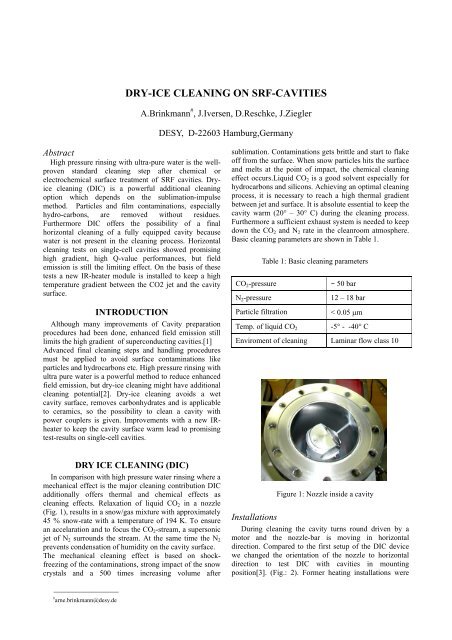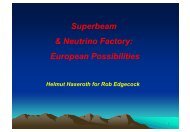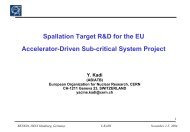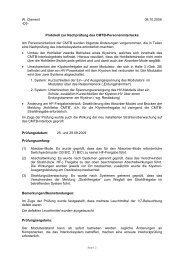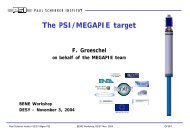Dry-Ice Cleaning on SRF-Cavities A. Brinkmann, J. Iversen, D ... - Desy
Dry-Ice Cleaning on SRF-Cavities A. Brinkmann, J. Iversen, D ... - Desy
Dry-Ice Cleaning on SRF-Cavities A. Brinkmann, J. Iversen, D ... - Desy
You also want an ePaper? Increase the reach of your titles
YUMPU automatically turns print PDFs into web optimized ePapers that Google loves.
DRY-ICE CLEANING ON <strong>SRF</strong>-CAVITIESA.<strong>Brinkmann</strong> # , J.<strong>Iversen</strong>, D.Reschke, J.ZieglerDESY, D-22603 Hamburg,GermanyAbstractHigh pressure rinsing with ultra-pure water is the wellprovenstandard cleaning step after chemical orelectrochemical surface treatment of <strong>SRF</strong> cavities. <str<strong>on</strong>g>Dry</str<strong>on</strong>g>icecleaning (DIC) is a powerful additi<strong>on</strong>al cleaningopti<strong>on</strong> which depends <strong>on</strong> the sublimati<strong>on</strong>-impulsemethod. Particles and film c<strong>on</strong>taminati<strong>on</strong>s, especiallyhydro-carb<strong>on</strong>s, are removed without residues.Furthermore DIC offers the possibility of a finalhoriz<strong>on</strong>tal cleaning of a fully equipped cavity becausewater is not present in the cleaning process. Horiz<strong>on</strong>talcleaning tests <strong>on</strong> single-cell cavities showed promisinghigh gradient, high Q-value performances, but fieldemissi<strong>on</strong> is still the limiting effect. On the basis of thesetests a new IR-heater module is installed to keep a hightemperature gradient between the CO2 jet and the cavitysurface.INTRODUCTIONAlthough many improvements of Cavity preparati<strong>on</strong>procedures had been d<strong>on</strong>e, enhanced field emissi<strong>on</strong> stilllimits the high gradient of superc<strong>on</strong>ducting cavities.[1]Advanced final cleaning steps and handling proceduresmust be applied to avoid surface c<strong>on</strong>taminati<strong>on</strong>s likeparticles and hydrocarb<strong>on</strong>s etc. High pressure rinsing withultra pure water is a powerful method to reduce enhancedfield emissi<strong>on</strong>, but dry-ice cleaning might have additi<strong>on</strong>alcleaning potential[2]. <str<strong>on</strong>g>Dry</str<strong>on</strong>g>-ice cleaning avoids a wetcavity surface, removes carb<strong>on</strong>hydrates and is applicableto ceramics, so the possibility to clean a cavity withpower couplers is given. Improvements with a new IRheaterto keep the cavity surface warm lead to promisingtest-results <strong>on</strong> single-cell cavities.sublimati<strong>on</strong>. C<strong>on</strong>taminati<strong>on</strong>s gets brittle and start to flakeoff from the surface. When snow particles hits the surfaceand melts at the point of impact, the chemical cleaningeffect occurs.Liquid CO 2 is a good solvent especially forhydrocarb<strong>on</strong>s and silic<strong>on</strong>s. Achieving an optimal cleaningprocess, it is necessary to reach a high thermal gradientbetween jet and surface. It is absolute essential to keep thecavity warm (20° – 30° C) during the cleaning process.Furthermore a sufficient exhaust system is needed to keepdown the CO 2 and N 2 rate in the cleanroom atmosphere.Basic cleaning parameters are shown in Table 1.CO 2 -pressureN 2 -pressureParticle filtrati<strong>on</strong>Table 1: Basic cleaning parametersTemp. of liquid CO 2~ 50 bar12 – 18 bar< 0.05 μm-5° - -40° CEnviroment of cleaning Laminar flow class 10DRY ICE CLEANING (DIC)In comparis<strong>on</strong> with high pressure water rinsing where amechanical effect is the major cleaning c<strong>on</strong>tributi<strong>on</strong> DICadditi<strong>on</strong>ally offers thermal and chemical effects ascleaning effects. Relaxati<strong>on</strong> of liquid CO 2 in a nozzle(Fig. 1), results in a snow/gas mixture with approximately45 % snow-rate with a temperature of 194 K. To ensurean accelarati<strong>on</strong> and to focus the CO 2 -stream, a supers<strong>on</strong>icjet of N 2 surrounds the stream. At the same time the N 2prevents c<strong>on</strong>densati<strong>on</strong> of humidity <strong>on</strong> the cavity surface.The mechanical cleaning effect is based <strong>on</strong> shockfreezingof the c<strong>on</strong>taminati<strong>on</strong>s, str<strong>on</strong>g impact of the snowcrystals and a 500 times increasing volume afterFigure 1: Nozzle inside a cavityInstallati<strong>on</strong>sDuring cleaning the cavity turns round driven by amotor and the nozzle-bar is moving in horiz<strong>on</strong>taldirecti<strong>on</strong>. Compared to the first setup of the DIC devicewe changed the orientati<strong>on</strong> of the nozzle to horiz<strong>on</strong>taldirecti<strong>on</strong> to test DIC with cavities in mountingpositi<strong>on</strong>[3]. (Fig.: 2). Former heating installati<strong>on</strong>s were_________________# arne.brinkmann@desy.de
not efficient enough, more heater power was needed. Acompany made IR-heater system with 8 shortwave twintube heaters and a maximum power of 5.6 KW is installednow (Fig.:3 and 4) The wavelength is 1.0 μm – 1.4μm.With this heating power and wavelength the cavity is notfrosted <strong>on</strong> the outer surface during the cleaning process.The temperature is measured with a IR-Temp.Sensor.The exhaust system ensures a harmless CO 2 –c<strong>on</strong>centrati<strong>on</strong> in the cleanroom and keeps particles awayfrom the cavity.CO 2 and O 2 c<strong>on</strong>centrati<strong>on</strong> in the cleanroom atmosphere,cleanroom fans and exhaust are c<strong>on</strong>trolled by aninterlock-system, which automatically stops the gassupplyif <strong>on</strong>e of these comp<strong>on</strong>ents or c<strong>on</strong>centrati<strong>on</strong>s failsor gets too high.1,00E+11Qo1,00E+101,00E+09RF-TEST RESULTSQo/Eacc1DE7 BD1DE4 FE1DE7 FE1DE7 PWR1AC4 BD1,00E+081,00E+070 5 10 15 20 25 30 35 40 45Eacc [MV/m]Figure 2: horiz<strong>on</strong>tal orientati<strong>on</strong> of nozzleFigure 3: IR-heaterFigure 5: Test resultsFig.5 shows some RF-test results of several 1-cellcavities. No previous cleaning steps were applied to thecavities before dry ice cleaning. The cavities were storedunder cleanroom-air or kept under vacuum and ventedwith particle-filtered N 2 . In all tests maximum gradientsabove or at 30 MV/m were achieved. The tests showedtypical Q-values above 10 10 at 2 K for superc<strong>on</strong>ductingcavities at 1.3 GHz. High Q-values indicate that DIC notc<strong>on</strong>taminates the inner cavity surface. An optimizedcleaning and handling procedure led to a RF-test with agradient up to 38 MV/m limited by breakdown. Fieldemissi<strong>on</strong> is still a limiting factor, but most likely causedby particle c<strong>on</strong>taminati<strong>on</strong> during assembly of the cavities.Figure 4: IR-heaterSUMMARYIt was shown that no previous cleaning steps like highpressure water rinsing applied to cavites is necessary toobtain high performance in RF-tests. The new IR-heaterwith optimal wavelength and countoured alignment of thetube heaters provides a high thermal gradient betweenCO 2 -jet and Cavity-surface. A safety interlock is build toc<strong>on</strong>trol gas c<strong>on</strong>centrati<strong>on</strong>s. Field emissi<strong>on</strong> is a limitingfactor, but surely caused by particle c<strong>on</strong>taminati<strong>on</strong> duringfinal assembly of the cavity. Particle c<strong>on</strong>taminati<strong>on</strong>during the cleaning procedure is almostnegligible,nevertheless particles must be m<strong>on</strong>itored. Insome cases the particle counter showed a very high rate ofparticles, but this occurred due to a defect in the exhaustsystem.
ACKNOWLEDGEMENTWe acknowledge the support of the EuropeanCommunity Research Infrastructure Activity under FP6“Structuring the European Research Area” program(CARE, c<strong>on</strong>tract number RII-CT-2003-506395REFERENCES[1] D.Reschke, Proc. 10 th Workshop <strong>on</strong> RFSuperc<strong>on</strong>ductivity, Tsukuba, Japan, p.144 (2001)[2] D.Reschke et al., Proc. LINAC 2004, Lübeck,Germany, p.776 (2004)[3] A.<strong>Brinkmann</strong> et al., 12 th Workshop <strong>on</strong> RFSuperc<strong>on</strong>ductivity, Ithaca, USA


